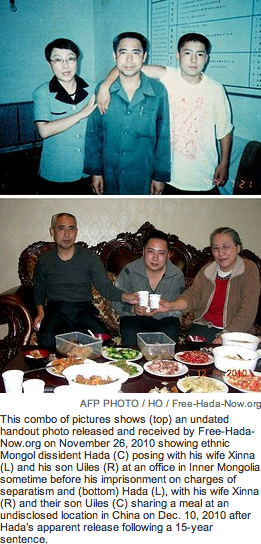 |
|
|
|
The same day one imprisoned Chinese dissident was awarded the Nobel Peace Prize, another appears to have gone missing.
Hada, an ethnic Mongolian activist imprisoned for 15 years on charges of separatism, has been released from prison, according to a Mongolian rights group, but it’s not clear where he is and it appears likely he is still being detained.
The 54 year-old was supposed to be released from jail in the Inner Mongolian city of Chifeng on Friday. Pictures stamped with Friday’s date and posted on the website of the Southern Mongolian Human Rights Information Center yesterday show Hada with wife Xinna and son Uiles in what appears to be a private hotel dining room.
According to a statement on the SMHRIC website, a “State Security” official handed a compact disc containing the photos to Hada’s sister-in-law Naraa on Sunday.
“Judging from the clothes Xinna and Uiles are wearing, these pictures seem to be pretty recent and authentic” Naraa is quoted as saying in a statement from SMHRIC, “but the three are still not set free.”
AFP reported late last month that authorities had detained Mongolian activists and were preventing family from visiting Hada in the run-up to his release. Xinna and Uiles were detained by authorities in early December and had not been heard from since, according to SMHRIC.
In a report Monday, Associated Press quoted Naraa confirming that she had received the photos, and that she had yet to hear from Hada, his wife or his son.
Hada was one of the founders of the Southern Mongolian Democratic Alliance, a Mongolian rights group Beijing accuses of advocating separatism–the same charge China has leveled at the Dalai Lama and exiled Uighur rights advocate Rebiya Kadeer. Hada’s wife, Xinna, has previously denied the government’s allegations, saying she and her husband were simply trying to protect the rights of Mongolians, Reuters says.
While tension between the Chinese government and ethnic Mongolians is far less talked about than with Tibetans or Uighurs, the issues are similar. As with Tibet and Kadeer’s native Xinjiang, Inner Mongolia is a resource-rich region that has witnessed a steadily increasing flood of Han Chinese immigration in recent decades. According to figures from the most recent census, Han Chinese account for roughly 80% of Inner Mongolia’s population, while ethnic Mongolians represent around 17%. With Beijing pushing development of the region’s ample coal reserves, the percentage of ethnic Mongolians is destined to shrink even further.
Inner Mongolia supplanted Shanxi as China’s top coal producing region last year thanks to a black gold rush that has given to speculative boomtowns and epic traffic jams.
Ethnic tensions have grown along with the economy, as Mongolians complain the development favors Han Chinese.
Concern over such tensions was blamed for the government’s decision in 2004 to cancel a performance in the Inner Mongolian capital of Hohhot by Hurd, a Mongolian-pride metal band from Ulanbataar.
The ethnic strife has expanded beyond China’s borders in recent years, helping give rise in Mongolia proper to a handful of ultra-nationalist groups angry at the presence of Chinese companies and workers in their country.
Fear of a resurgence in Mongolian rights rhetoric might explain the government’s silence on Hada’s status. Asked by Reuters to confirm Hada’s release, Wen Fei, a spokesman for the Inner Mongolia government said he had never heard of the activist: “If he’s out of jail how should I know where he is, and if he’s in jail then I also don’t know where he is.”
– Josh Chin. Follow him on Twitter @joshchin







